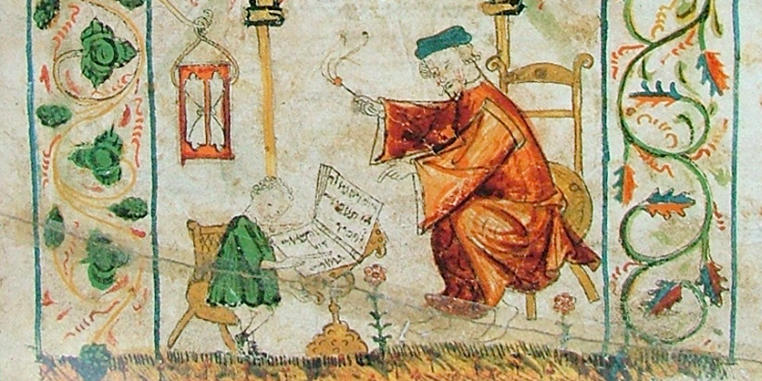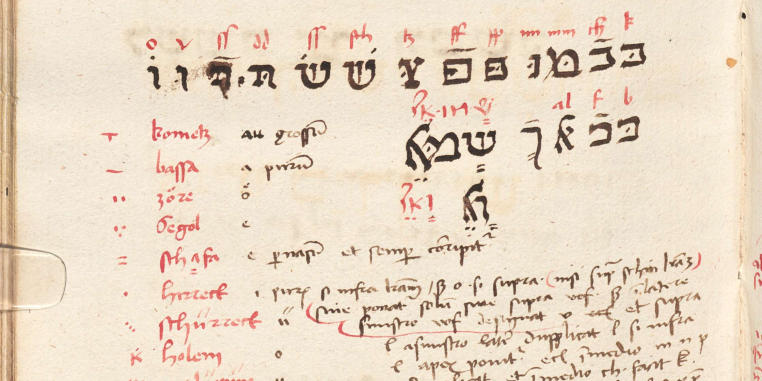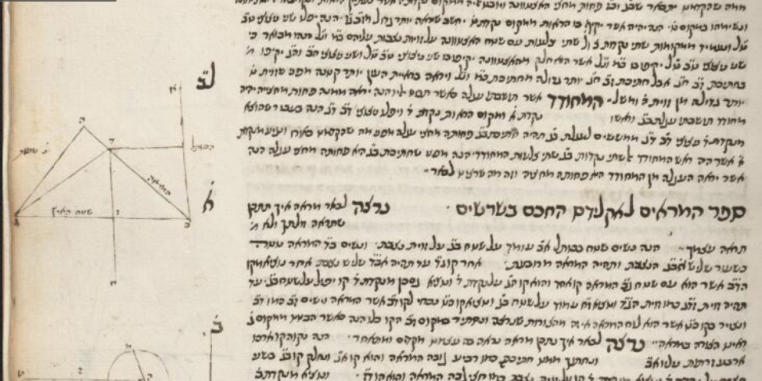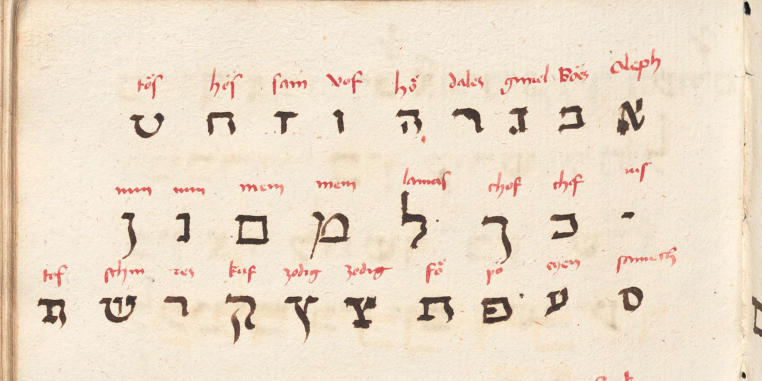







This project deals with a fourteenth-century royal cartographer, a Majorcan Jew immersed in the legacy of ancient Greek and Arabic science, who also commanded expertise in Hebrew scribal work and illumination at the highest level. In these different capacities Elisha ben Abraham Bevenisti Cresques (1325–1387) conveyed and negotiated diverse intellectual and artistic traditions. A mapmaker in the service of the kings of Aragon, Elisha (commonly referred to as Abraham Cresques in the literature) functioned as a channel for the communication of his royal patrons’ Christian worldview. An accomplished Hebrew scribe and illuminator, he also created a masterpiece of Sephardi Bible illumination, a work that stands at the apogee of Iberian Jewish art. He was a dedicated bibliophile and the owner of a large codex comprising a whole range of texts of various interests, his own private library, so to speak. Looked at from different perspectives, Elisha Cresques emerges as an intellectual “hub,” where mapmaking converges with scribal work, miniature painting with scientific knowledge, and the culture of a minority with that of the majority.
The results of this project will appear in a monograph by prof. Katrin Kogman-Appel, expected to appear in 2019 (Books and Maps in Fourteenth-Century Majorca – The Intellectual Profile of Elisha ben Abraham Cresques), and the following papers:
The project examines medieval Jewish textual evidence about visuality, visualization, and different functions of the visual in various contexts: halakhah, magic, science. The project aims at analyzing findings from various sources in an interdisciplinary, integrative approach against the background of methodologies applied in the research of acculturation and cultural exchange in the field of social history and historical anthropology.
Dr. Katelyn Mesler:
Representation and Identity in Medieval Jewish Magic
My project concerns the understandings of visuality implicit in certain Jewish magical practices of the Middle Ages. In particular, I am interested in those practices that rely strongly on notions of representation in order to posit a form of identification between a person and an object. The clearest example is invultuation, most commonly known today in the form of Voodoo Dolls, in which a figurine is produced in order to represent a specific person and, furthermore, is identified with that individual in such a way that actions taken against the figurine affect the person. I am thus investigating the evidence for Jewish practice of invultuation and for the underlying assumptions about representation and identity.
Dr. Josefina Rodríguez-Arribas:
I am researching visual aspects in the context of astrolabe manuscripts written and copied in Hebrew between the fourteenth and eighteenth centuries. It is well known the essential role of diagrams and drawings in technical handbooks to describe the construction, to illustrate the object, or to verify or prove the theory. I am exploring how medieval and early modern Jewish readers might have understood these technical images and what might have been the actual knowledge that they could extract from them. I am exploring this question through two groups of diagrams/drawings: those explaining the construction of astrolabes (mainly dealing with the projection) and diagrams that represent the final result, i.e. the object itself as it should look when the construction is finished. As a rule, astrolabe diagrams should appear almost always in treatises explaining the construction rather than in those dealing with the uses of the instrument, while illustrations of astrolabes should appear in treatises dealing with the uses of the instrument, but there is a great deal of exchange. At the same time, I am considering differences according to the Jewish cultures that produced these images, either diagrams or illustrations, so that Ashkenazi and Sephardic technical drawings and illustrations are interpreted in their proper contexts.
Dr. Sabine Arndt:
Mathematical optics in medieval Hebrew manuscripts
My project concerns mathematical approaches towards visuality in medieval Judaism. In particular, I am interested in medieval Hebrew writings on geometrical optics, that is, the science of rays – their propagation, reflection and refraction. No original Hebrew works by Jewish authors devoted solely to optics survived, but translations of two tracts came down to us: Euclid’s Optica (Sefer hiluf ha-mabatim) and an anonymous text that was attributed to Euclid in the Middle Ages: De speculis (Sefer ha-mar’im). I am investigation the transmission history of these texts, with a focus on the following questions: What was the status of optics within the medieval Jewish scientific curriculum? Were translators, copyists or readers familiar with scientific treatises in languages other than Hebrew? How did translators, copyists and readers deal with erroneous texts and with erroneous diagrams, and what can their strategies in coping with errors tell us about their scientific knowledge and their understanding of the relationship between text and image?
Results of this project will appear in individual articles by researchers and a collective volume with contributions delivered at the conference, expected in 2019: The Visual and the Material in Medieval and Early Modern Jewish Cultures, ed. Katrin Kogman-Appel, Elisheva Baumgarten, Elisabeth Hollender, and Ephraim Shoham-Steiner.
From the moment the idea of multiple reproduction began to occupy the minds of makers of books in the fourteenth century, the manuscript and the printed book entered into a complex relationship. Over some centuries these two media co-existed and their ways often crossed. The project examines the cultural, religious, social and economic background of illustrated Hebrew books in Europe during this crucial period in the history of the book. First changes in the culture of books occurred since the late fourteenth century in the German Lands in the style and techniques of illustration, changes that appear to be a by-product of the emergence of print culture. These changes, observable also in vernacular and Latin book history, reflect the economic and social developments that ultimately led to the printing press. The project will identify these changes as they can be observed specifically in Hebrew manuscripts, compare them to similar processes in non-Jewish book production, and examine them against the background of social and economic developments during that period within the different Jewish communities.
Prof. Katrin Kogman-Appel
Débora Marques de Matos
Rodica Herlo-Lukowski
Joel ben Simeon – ein jüdischer Schreiber und Maler als Zeitzeuge der Entwicklung des Buchdrucks
Das bedeutendste Ereignis des 15. Jahrhunderts für die Buchgeschichte war die Erfindung des Druckverfahrens mit beweglichen Lettern. Hebräische Bücher wurden erstmals in Rom um 1470 gedruckt. Das Promotionsprojekt versucht, von einer Gruppe ausgewählter und signierter Handschriften Joel ben Simeons ausgehend, den Übergang vom Handschriftenmedium zum Druckverfahren in der jüdischen Buchkultur zu verstehen. Joel ben Simeon wurde mit den gleichen Faktoren und sozioökonomischen Entwicklungen, die das Aufkommen der Buchpresse eingeleitet haben, konfrontiert. Seine Handschriften werden auf mögliche Reaktionen des Schreibers und Malers auf die Herausforderungen durch die sich ändernde Lesekultur, den Buchmarkt und die neue Leserschaft untersucht, wobei der Fokus meiner Dissertation auf die Bildersprache gelegt wird. Es soll untersucht werden ob die Handschriften bereits eine serielle Produktion signalisieren, die innerhalb des Illustrationsprozesses zu erkennen sei und ob sie auf eine ökonomischere Art der Herstellung durch die Beschleunigung des Malprozesses und Reduzierung des Kostenfaktors hindeuten. Die Analyse seiner Handschriften soll im Hinblick auf diese Fragestellung im Vergleich mit ausgewählten jüdischen Druckerzeugnissen der Frühphase erfolgen. Meine Arbeit will versuchen, von der Handschrift als Artefakt ausgehend, die Überlegungen des jüdischen Handschriften-Herstellers zu den Änderungen in der Buchkultur nachzuvollziehen und zu beleuchten, und somit neue Erkenntnisse über diese Zeit des Übergangs erbringen.
Dr. Ilona Steimann
'Jewish' Book - 'Christian' Book: Hebrew Manuscripts in Transition Between Jews and Christians at the Cusp of Eraly Modernity
An intriguing development in the late fifteenth and early sixteenth-century Christian Hebraism is how and why Christian Hebraist scholars came to produce their own Hebrew books. Aimed to be published as a monograph, this project offers a novel examination of this development in light of a nearly unknown group of around twenty Hebrew manuscripts produced by German Hebraists. Anticipating Hebraist printed editions of Hebrew texts, this group represents one of the earliest attempts of Christians to independently form a stock of Jewish literature, which would meet their scholarly needs and interests, and embodies the encounter of Jewish and Christian views of the Hebrew text and book. Based on the close examination of the Hebraist Hebrew manuscripts, my study addresses the motivations behind their production, practical complications involved, and their function and meaning in the Christian context. Its main objective is to examine various modes of transition of the Hebrew manuscripts from ‘Jewish’ to ‘Christian’ objects, and to explore how their Christian copyists reflected on their inherent ‘Jewishness’ and in what ways they adapted (or transformed) them to serve Christian needs from both material and textual perspectives.
Results of this project will appear in a dissertation by Rodica Herlo-Lukowski, a monograph by Ilona Steimann, and the following articles by prof. Katrin Kogman-Appel: